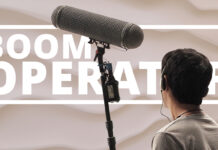There is no hiding the fact that, at first, microphone selection is daunting. This is a bit of a theme when it comes to audio. Don’t worry though, most of these challenges resolve themselves with time and experience.
High-quality audio is arguably more important now than ever before. Seeing a wireless pack during a YouTube video and hearing correspondingly good sound puts a smile on my face. With a sea of content available online, quality absolutely matters.
Overview
Sound engineering used to come across a lot more like, well, engineering. Microphones felt like a jumble of models, designs, and exotic price ranges. All bound by the physics of sound, or sometimes the sound of physics, one can never be sure of choosing the right mic when first getting a handle on things. The point is that good sound used to be quite a bit more difficult and required a hefty investment of upfront knowledge. This does not diminish the value of seeking degrees and certifications in sound engineering. Rather, that the concepts taught in those programs have been steadily gaining more mainstream adoption. Even the academic route has started offering more options in terms of a more technical or musical curriculum and approach. The sound engineers of 30 years ago were also dual majoring in electrical engineering. How times change.
Fast forward to today and the barrier to entry into professional audio has significantly dropped in the last decade, both in terms of knowledge and equipment. The amazing range of products and accessible price points has made microphone selection much easier.
Microphone designs and patterns
The majority of microphones fall into one of two camps, dynamic or condenser. Condensers require external power, +48v of phantom power, while dynamic microphones work as-is. We will not be including ribbon microphones in this article, there have been some pretty amazing developments in making ribbon microphones more robust.
For more detailed information on microphones including design, positioning, including ribbon microphones you can refer to our article on microphone placement.
After the design, a microphone’s next most important characteristic is its polar pattern. This determines directionality and is a common reason for a particular microphone selection.
Packaging
Saying that microphones come in many shapes and sizes does not overstate things, and what a great advantage to have. Different microphone designs require packaging solutions to meet their application requirements.
Condenser microphones are a good example. Models come in small, regular, and large-diaphragm sizes. Pencil condensers are a popular choice for overhead microphones on stages and drum kits alike, the small diaphragm design requires less movement and contributes to the microphone being more sensitive to mid and high frequencies. There is a trade-off with the smaller capsule having a lower maximum sound pressure level before distorting.
The same logic applies in the other direction. Larger diaphragm condensers are great and offer great vocal pick up, you can sing, yell, and generally emote into them. They are also equally at home with louder instruments like guitars and bigger drums like toms and snares. It’s not surprising that a shotgun mic is a super-cardioid condenser turned up to 11
The last example shrinks the packaging down to the lavalier level and things are hopefully starting to click. A lavalier condenser combines a small diaphragm and a more sensitive condenser design. The result is a portable and robust microphone capable of picking up the human voice and staying out of the way.
Polar patterns
This is a brief overview of the common polar patterns and what they mean. The polar pattern refers to the shape and arrangement of the magnetic field surrounding a microphone’s capsule.

Cardioid
Named for its heart-shaped (cardio) pattern, this is a type of directional pattern. The two derived patterns are super and hyper-cardioid, which tighten the front-facing directionality and add some rearward pickup. Overall this is a common pattern found in many microphones including cardioids, shotguns, and lavaliers.
Omnidirectional
Like the cardioid, this is another common pattern. Omnidirectional microphones make great room microphones and represent the other half of the lavalier family. Fun fact, all microphones start life as omnidirectional microphones before being packaged into a directional design.

Figure 8 or Bi-Directional
A very literal example of “it does what it says on the box”, the figure 8 pattern is particularly effective in rejecting sounds from the side. They are not the most common in daily use, but certainly have a place when it comes to stereo recording techniques. The Blumlein pair is a pair of figure 8 microphones positioned at 90°.
It is worth mentioning that a figure 8 microphone in a quiet setting is still suitably directional, particularly if there are no offending sounds present behind the microphone.
Choosing the right mic for you
When it comes to microphone selection, things have been a little different for a while now. There really isn’t a sector left untouched by e-commerce, which has paired large catalogs with rapid availability. This undoubtedly works for the majority of equipment purchases, including microphones. There are moments where you absolutely need to use, hear, and feel a mic for yourself.
With all of that said, do your homework during the buying process, but remember to take it in stages, this knowledge and experience do not come overnight. Read reviews both in articles and on forums. Check the product and specification sheets and pour over all the pictures.
Aspects like build quality and connector types matter and make a difference with long-term ownership, especially if you are buying into an ecosystem of products.
What to look for
Every microphone selection should serve a purpose. For example, the number of microphones you own accounts for your typical high track count, whether it is five or a dozen.
What makes each microphone special is its sound. This quality comes from its design, polar pattern, and those physics we mentioned earlier. This quality is both objective and subjective, a microphone can look great on paper, but it might not sound right to you, or doesn’t fit the desired use case.
There are some staple pieces that can be bought sight unseen, a certain Shure microphone comes to mind. Experience is otherwise king in these moments. Finding diamonds in the rough is equal parts rewarding and frugal, it pays to shop around.
Hands-on experience and getting to try before you buy is the best way of testing a microphone and making a buying decision. In lieu of access to an inventory or local availability try considering the following. Loaning or borrowing, deposits are still a thing in some places. Try to surface both written and video reviews from reputable sources before taking the plunge.
Online stores have generous return policies and 30 day return periods are common, please use them responsibly and do your research before committing to a purchase. Shipping has financial and environmental costs, companies do keep track of returns and will notify customers of excessive usage or if they suspect malicious use.
Operation and environment
The big question here is, will it be seating for one or more? Working alone can be efficient, but has its drawbacks when it comes to productions requiring greater mobility.
Filming a static interview is relatively easy and straightforward. Position the camera, set the frame, check the script, and action. The talent is good to go with a wireless pack and neatly mounted placed lavalier. This setting even has scope left for movement, the wireless pack leaves the door open for movement because the solo filmmaker is still able to operate the camera.
The same applies to sound engineers. Lone-wolfing boom operation and recording duties is tiresome. Having some support or overlapping skills provides relief and helps maintain quality through the process.
Recording audio and video at the same time is challenging. That is why filmmakers, camera operators, and sound engineers exist; small teams of specialists are a powerful combination that opens many doors.
Microphone selection
Packing a gig bag makes it tempting to try and bring everything and plan for all sorts of scenarios. Avert this temptation with these simple questions.
- What are you shooting?
- Where?
- Do you need an assistant?
The project type and shot schedule determine what microphones and quantities to bring, always bring spares.
Location and distance will determine consumables like cables, stands, batteries, storage, etc.
The answers given here reflect your needs and can work like a reverse buyer’s guide.
Sample inventory
Microphones easily fit into multiple roles; however, they don’t multiply. It’s normal to own more than one example of certain models. The list below is a flexible collection that should cater to filmmakers and sound engineers alike
1x matched cardioid stereo pair
This is technically two microphones, but matched stereo pairs are an excellent choice for recording room and stage sound and open the door for stereo miking. Larger diaphragm microphones are the more versatile choice.
2x Dynamic cardioids
A directional microphone that requires no additional power. Dynamic cardioids are good at everything from handheld operation, podiums, vocal, and instrumental recording and capture.
2x Lavaliers and wireless packs
Two is a sensible starting point. Simultaneously recording two sources is common and odds are that an additional two wireless microphones are not far behind. This is about managing capacity and redundancy.
Think longer-term with this purchase. Going wireless means buying into an ecosystem and that does mean some research into expandability and product support.
1x Shotgun microphone
Another opportunity for versatility, look for a microphone that is equally at home on a camera mount and boom.
1x Omnidirectional microphone
A good choice to have in a pinch if there are no other room microphones or if other microphones are in use.
Supporting equipment
This includes audio recorders, cables, stands, clips, batteries, etc., and at least one field recorder can take XLR and has an integrated microphone pair.
Lessons learned and good habits
No one likes to end an article on a downer, but we all know that mistakes happen and that they are key to getting better. There are a few low-level mistakes that should hopefully never happen more than once. Here are some that you should be aware of.
- Always monitor and check your playback, the last thing you want is to find out you have a drive full of broken recordings.
- Is the recording button armed for that channel?
- Running out of batteries or charged devices.
- Visually inspect cables, a cable tester is handy especially when working on location where cables receive more wear and tear.
Take your time to plan, read, and practice using your equipment. Build up your experience and confidence through testing and experimentation. Listen for and learn the difference between microphones and their placement. Treat your microphone selections like the brushes they are and you will be painting up a storm in no time.








